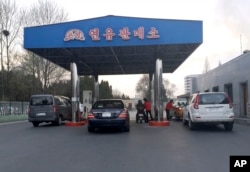While world attention has focused on Kim Jong Un’s recent missile tests, a monthlong surge in gasoline prices in Pyongyang is showing no signs of letting up, a puzzling problem that if allowed to drag on could be bad news for the North Korean economy.
Prices have shot up to about $2.30 per kilogram, or about $6.44 a gallon, since mid-April, when prices were in the $1.25-30 range. That means North Korea now has some of the highest prices in the world for gasoline. For comparison, the price in April last year was about 80 cents per kilogram.
The cause and extent of the surge remains a mystery.
Traffic unaffected
Officially, there has been no comment. There’s no obvious sign of less traffic on the streets, at least in Pyongyang, which is more affluent and developed than other North Korean cities. Taxis appear to be operating normally and have not raised their fares.
The North’s by now pervasive market economy, which is tolerated by the ruling regime in exchange for its cut of the profits, has made fuel and the ability to transport goods and people so essential that demand for gasoline is not so sensitive to price.
But many gas stations around the capital, if they are selling fuel at all, have been limiting who they sell it to and how much each customer can buy. The long queues and mad dashes to fill gas tanks and large plastic storage cans that marked the beginning days of the surge appear to have subsided, though stations’ operations remain irregular and unpredictable.
North Korean gas stations generally belong to chains associated with large government enterprises or sometimes the military. Gas is also sold through more informal channels, including street-side stalls and the black market. It is sold by weight in North Korea, thus the “per kilogram” rates.
What's behind this?
Without official confirmation or data, it’s hard to conclusively say what is happening. Prices also tend to fluctuate from station to station.
Several possible scenarios could be in play.
It was rumored last month that China had or was about to limit exports. That possibility, hinted at in a tabloid newspaper associated with China’s ruling party, could have set off the surge either because of an actual drop in supply or speculative buying in anticipation of a shortfall.
The incentive to hoard remains because of rumors Beijing will implement sanctions if Pyongyang conducts a nuclear test. It is unclear how informed North Koreans are about the possibility of another test soon, but satellite imagery widely reported abroad suggests one could come at any time.
The North Korean government itself might have pulled some of supply out of the market.
Pyongyang has been known to divert fuel to higher-priority uses, such as major construction projects or high-profile political events. Gas prices can also rise in tandem with the farming cycle, when more fuel is needed for tractors and pumps. All three could apply right now. North Korea completed construction of a major high-rise residential area in the capital and held a lavish celebration and military parade last month. This is also spring planting season.
The most ominous possibility is that the regime is preparing for some sort of emergency.
But there does not seem to be any strong evidence of that or of Chinese action to cut off supplies.
William Brown, an adjunct professor at Georgetown University and non-resident fellow at the Korea Economic Institute of America, said rumor-inspired hoarding is the likely culprit.
Sensitivity to sanctions
It’s unclear if prices are also rising for diesel and kerosene, used to heat and keep the lights on in city apartments and machinery working in the fields.
An acute sensitivity to even the hint of Chinese sanctions, if that is behind the surge, would be telling.
The Soviet Union supplied crude oil to North Korea in the 1950s through the 1980s. China joined in early 1970s and now provides virtually all of the North’s supply. Brown said that includes a 50,000-ton delivery monthly via an 18-kilometer (11-mile) cross-border pipeline that is worth about $20 million at current Chinese export prices.
Beijing doesn’t require the North to pay and hasn’t included those shipments in official trade figures since 2014.
If Pyongyang had to start paying for that 50,000-ton freebie, the profit from sales of what it refines domestically would drop and it would have less money to spend on other things. The resulting scarcity of dollars would hurt the value of North Korea’s currency, leading to inflation.
In any case, Brown said, the volatility of gasoline prices underscores the North’s dependence on markets that have expanded dramatically since Kim Jong Un took power more than five years ago. The rise of markets has led to better productivity and use of scarce goods, like gasoline, helping economic growth.
But, he added, it is at the same time “the bane of a socialist government.”
“Real money in private pockets, after all, is power,” he said.









